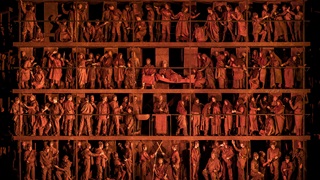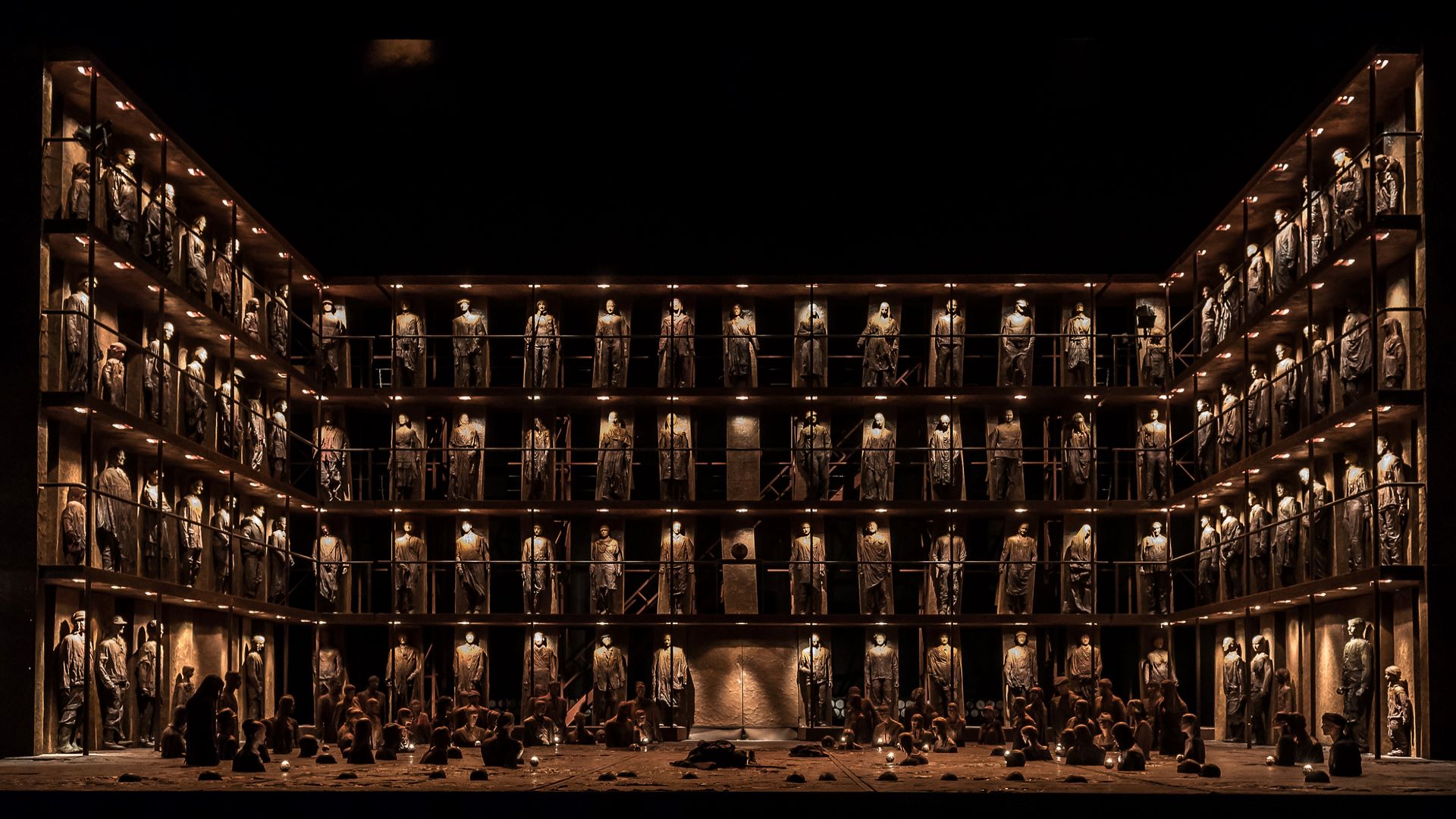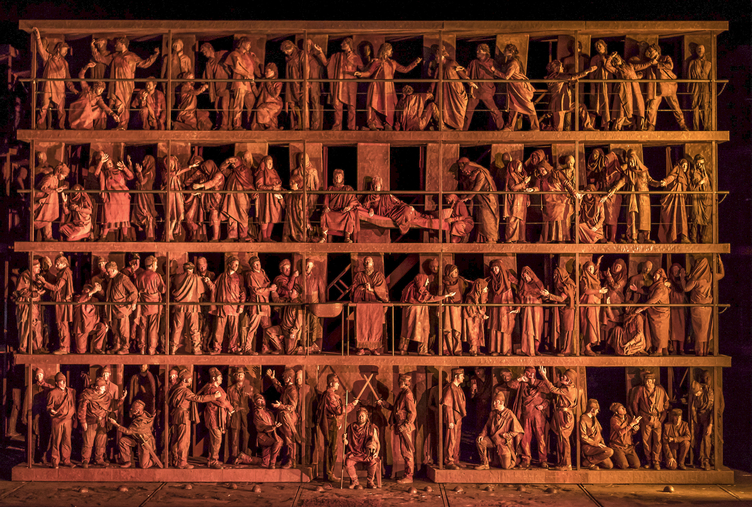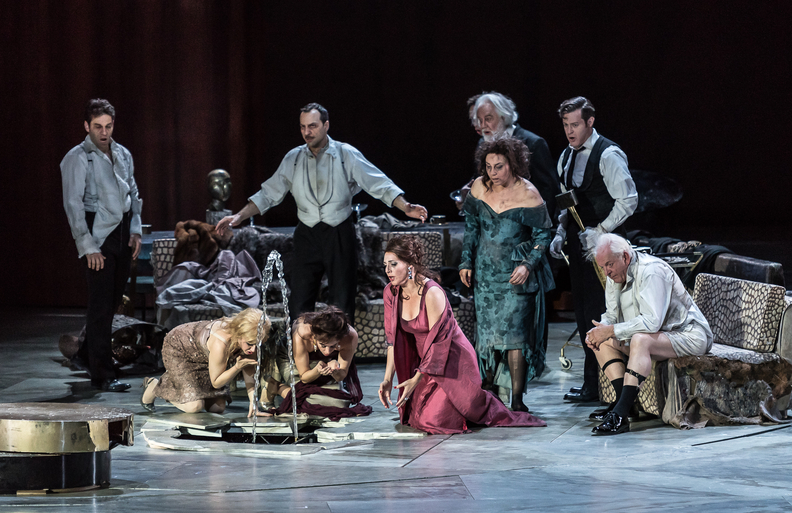
Features
Essays, stories, prose poems, surveys and critiques


OPERA |
IN THREE ACTS
Welcome to a night at the opera, and if this is your first time, come on in. This is opera with the sound turned down but with all the playful tricks of theatre come alive. Tonight, you can move freely from one opera to another to another. First up is an opera retelling a comic tale by the English poet of the fourteenth century, Chaucer—a tale that, like some of the best comedies, ends on a note of unexpected pathos. That’s followed by an opera which reworks the fate of Oedipus as recounted by the Greek playwright Sophocles in the fifth century BC. Our third opera is contemporary, surreal and inspired by the film work of the twentieth-century Spanish iconoclast, Luis Buñuel.
Between each opera is an interval. Make yourself a drink, get yourself an ice cream, go along to one of the talks. Where did opera start? Where is opera headed?
It’s theatre. And it’s free. For one night only.
A rich old man called Januarie picks out a milkmaid called May to be his bride. Their wedding night is bliss for Januarie but not for May, and she takes as her lover the old man's servant. Their actions are observed by the gods of the Underworld, Pluto and Prosperina, who argue over the rights and wrongs of the matter. Januarie, blinded by lust—and by Prosperina—has no inkling of the deception being played out on him. In front of his unseeing eyes, the young lovers climb into a tree to consummate their passion; and the god Pluto in anger at their behaviour restores the old man’s sight. May lies to Januarie and once again he is deceived (‘no fool like an old fool’). At the end, Januarie has died and is about to pass over—but the gods are merciful and allow him to think that the child that May is about to bear is his.
The Tale of Januarie—the first opera to be written in Middle English—was created for students at London’s Guildhall School in 2017 and is based on The Merchant’s Tale by Chaucer (1343‑1400). All the action takes place against the backdrop of a pear tree and the passing of the seasons.
“I was trying to write a piece that would have a broad appeal. I see opera within a broad theatrical context of theatre-making rather than as a very specialised high art. I can’t exist—operatically—in a world that is only pure and rarified. I need both ends of the spectrum.
I found Middle English incredibly rich and stimulating linguistically. Modern English is so problematic to set. You don’t have the lovely elisions and vowel‑rich possibilities that Italian and German and even French gives you. Middle English is a gift for a composer. It felt like I was setting an opera in a number of languages, because the language spoken in Chaucer’s time was in such flux.
Any new opera if it’s worthwhile involves an experiment. The risk from my point of view was writing a piece that seems at the outset to be bawdy and comic and that ends up having a tragic note. But that’s what interests me. That’s very much my sort of thing. It’s about being in between things.
In Chaucer’s tale, ‘Januarie’ marries ‘May’; we completed the cycle of the seasons and added an epilogue which took him to the point where he passes over to the Underworld. When we workshopped the end I did some cutting to tighten it. The worry is that you get to that point just when people are thinking it's time to go home—and you’ve got an extended meditation on the meaning of life! Of course, we were working with a young cast whose ideas about the passing of time were different to our own. There’s a poignancy in that. Those of us further down the path have a different sensibility about mortality and the brevity of life.
There is never enough time. The composition took a year; and that felt very tight. In a way, a creative process never ends; it’s just that at some point you really do have to stop. With opera, that dilemma is played out in a very stark way. Opera is so expensive and involves so many people. So everything hinges on what’s practical. You can cut, but you can’t revisit and remake.
Chaucer has this capacity to bring together a bawdy rough humour with high poetic thoughtfulness. He’s exploding the notion of difference between high and low art—just as Shakespeare does. You’re laughing at someone you think is ridiculous; and then you end up feeling this extraordinary empathy for him. The fact is that we’re all on the same mortal coil: we’re all ridiculous. That’s all there in the Chaucer.”
Where does opera come from?
A talk by Laurence Slater
Opera has only been around for about four hundred years. You could say it was invented, by committee. And it is fundamentally illogical. People don’t sing when they speak: they speak. Yet what we have at the beginnings of opera is recitative, endless acres of speech‑sung. And for this, we can thank a bunch of Florentine poets, musicians and intellectuals in the late 1500s, in particular Jacopo Peri, the composer of the first opera, Dafne. Not that people did thank Peri: the composer was uncredited and the score unpublished. Music in Europe, other than folk, was until the late Middle Ages liturgical; its shift into the secular realm began in the 1500s and drew on the practice of commedia dell'arte. The traditions of theatre, pantomime and liturgy came together when the Florentine camerata (Jacopo and his friends) decided to set a play to music. Three years later, Peri did it again: his second opera, Euridice, was performed in 1600. Things moved quickly after that point—with the arrival of Claudio Monteverdi—but it’s worth pausing to note three facts: that there was not a single aria or other melodic device in those early compositions; that the storylines looked back to Antiquity, its influence traceable throughout the mediaeval period; and that the camerata could never have created an opera without the support of their patron, the Count Giovanni di’Bardi. He is the one we should be thanking. Monteverdi—the greatest composer of his day—pushed opera into being as a flesh-and‑blood art form when he said that what it needed was a little variety. Orfeo was performed in 1607 in Mantua. Opera had arrived. And why? All because the wealthy Duke Gonzaga of Mantua heard Peri’s Euridice, decided he wanted one too, and instructed Claudio to learn the form and write him one. No patron, no exquisite art. Let’s not delude ourselves: opera was from the start an exclusive and private treat for a wealthy, well‑connected group of individuals. This changed only when, in 1637, the first opera house opened to the public—the Teatro San Cassiano in the Free City‑State of Venice—and even then the prices were horrendous. What would it take for opera to throw open its doors to the hoi polloi?
Oedipus is a man born to a tragic fate: he is destined to kill his father and marry his mother. Abandoned at birth and raised in a foreign land, he flees to escape his destiny. He kills a stranger—his true father—at a crossroads. He outwits the Sphinx and weds the Queen of Thebes—his birth mother. Years pass. Children are born. Peace is abroad. Then plague strikes the kingdom, and his search for truth as a means of ending the plague leads him to the knowledge of his actions. To atone, Oedipus blinds himself and, with his daughter Antigone, wanders the land. Years pass. Grief grows old. At the last, Oedipus finds peace.
The opera Oedipe had its premiere in Paris in 1936. It was composed by a Romanian, George Enescu, who started playing with the idea in 1910. The opera is based on plays by Sophocles: Oedipus Tyrannus and Oedipus at Colonus. This production (by the Catalan theatre group La Fura dels Baus) was first staged at La Monnaie, Brussels, in 2011.

Photograph by Clive Barda for the ROH
“It was our set designer Alfons Flores who suggested using clay as a visual leitmotif. It speaks to so many things. The creation of the first human from primeval clay. Our connections with Antiquity through its sculptures; you see this in the two hundred terracotta figures filling the tiered galleries, in their posture, the monochromatic colour of their robes. The enduring flow of time. And the chorus—as onlookers bearing witness to a man’s life—play a central role in Oedipe; the warm, earthen tones of clay gave us a way of unifying them. And of course the plague: the clay symbolises the sickness.
Jean Cocteau wrote a play in 1932 called La Machine Infernale; this made me think about time as perpetual motion and our helplessness in face of this onward sweep—and our fear of the future. In Oedipe, only one person acts to change their destiny, and that is Oedipus. We show his humanity throughout our production. His life was tragic. But we remember him. Down through the whole measure of time we still remember this man Oedipus.”
“I don’t believe in predestination: some book in which my life is written. No! Life is full of vicissitudes. The more Oedipus struggles, the more difficult his life becomes. I had to find an image to show this. The red clay came from TV images of a catastrophe in Hungary, but you see it too at Chernobyl. People will suffer for years: impossible to escape.
All my work is a way to express my feelings‑about love, justice, madness, desires. I lived for eighteen years under a dictatorship. I know these things.
People ask how I can work all the time in darkness, from morning till late at night on the stage of the opera house, no light, no outside world. But this is my joy. As a child I played on the stage, hammering nails, while my father did his work as a technician. Now it's the same, it’s play!
I have a lot of pain inside. I have two lives: in my public life I am a happy man; when I am alone I am a sad person. Theatre gives me the possibilities to speak about these feelings.”
SECOND INTERVAL
Where is opera going?
A talk by Laurence Slater
If people take against opera, it won’t flourish. It has to have its patrons, but it also has to be accessible to all, not just the cognoscenti: otherwise it has no future. Opera always illuminates something else: a myth, a Shakespeare play, a Greek drama, a moment in history. I would never say that opera is vital for life—clearly it isn’t!—yet it is a wonderful source of entertainment and it can be intensely moving. But not always. In the 1960s and ‘70s opera was in a state of confusion. New operas became—like the ‘plink plonk’ of much post‑war music—impossible to understand. Audiences ran for shelter to the familiar, the Verdi, the Puccini. For many, the new was regarded with horror, or apprehension. The form was pushed to its limits by, among others, Stockhausen’s Donnerstag (aus Licht), first seen at La Scala in 1981, and Birtwistle’s 1986 The Mask of Orpheus, which included a fusion of electronic synthesis in Act II that stunned audiences into a depressed silence. (His Minotaur is far more accessible.) The minimalist composers of the 1980s, people like Philip Glass and John Adams, were instrumental in enabling modern opera to absorb fresh ideas that would open it up to a wider audience. Over the last two decades there has probably been a levelling out; opera is, once again, melodic. That’s not the only change that has occurred but that is where opera’s future lies. Over these four hundred years our sound world has expanded. Wagner changed the way key structures work. Puccini had more notes to play with than Mozart. Stockhausen exploded the form. And now, as the age of minimalism passes, lyricism lives on, in a new, sometimes challenging, form. We have a living example of that in Thomas Adès, who has developed a style of modernism that is bringing people to the opera houses in droves. Music is always changing, as is our receptivity to it. Where is opera going? Into the future.
A group of rather glamorous people arrive (twice) to attend a dinner party. At the end of the evening they find they cannot go home, although there is nothing to prevent their doing so. No sealed doors. No guards. Time passes and still no one leaves. Order and civility collapse. Lust, anger, sex and madness creep in, as do hunger, thirst, sickness and death. At a certain point, they do leave; and they enter an uncertain world, with no fixed frame of reference.
The Exterminating Angel had its premiere in Salzburg in 2016 and its UK premiere at the Royal Opera House in 2017. It is based on a 1962 film by the master of cinematic surrealism Luis Buñuel: El Ángel Exterminador. The composer is Thomas Adès.

Photograph by Clive Barda for the ROH
“Summoning us, the bells toll as we file in, find our seats and observe the sheep wandering footloose on the stage. The servants flee and the guests arrive. And then arrive again, the whole welcome scene replayed. Civilities over, the courtesies begin and dinner is served, music is played and the evening comes to an end. That’s when the surreal horror starts. Why don't they just go home? But they don’t. They have lost the will to act. God have mercy on me, I think; let me out of here. When the interval comes I stumble out into the Crush Room at Covent Garden, where I see men and women at small tables with glasses of wine, studying the menu. Is there no end to this night? Outside, on the street, a thin man with a cup in his hand asks for change. Returning to my seat, I hear people talk of the menace, the captivating atmosphere. The second half begins and it seems that we have arrived in Hell, in Buñuel’s vision of filth, violence, incest and the stench of the corpse. Time no longer has meaning. A bear appears in great hulking form. Death flies among them. Water, food, fire: elemental needs. Sex. Desire for blood (sing three of the women, who appear to have formed a coven). There is no relief—not even when they emerge.
As we leave the opera house I hear people talk of the translucent score. My companion says that this is high art and it is a good thing to be left with questions without answers.
Thomas Adès is a wunderkind of contemporary music and now, at 46, critics say he has reached a turning point. ‘I do feel’, he tells the BBC, ‘that this is a coming‑out piece as a composer.’ Is it because of the sheep? The singers compelled to sing at the vocal limits of their range? Or the extraordinary impact that this piece has on its audience? ‘I spent years on this’, says Adès. ‘When you’re writing it, that’s your reality. It's quite a bleak vision but it’s energising. …If the music needed to go somewhere, I wanted it to go there, no matter where it was.’ Adès describes the experience of The Exterminating Angel as taking the audience ‘bit by bit down the wormhole into this vision of Buñuel…like walking into the sea. It comes up over your ankles and then over your knees and by the end you’re really in deep water.’”
Act I
The Tale of Januarie
Based on Chaucer’s Canterbury Tales
Music by Julian Philips
Libretto by Stephen Plaice
Director Martin Lloyd‑Evans
Set designer Dick Bird
Januarie was played by John Findon
Professor Julian Philips is head of composition at the Guildhall School of Music and Drama
Stephen Plaice is writer‑in‑residence at the Guildhall School of Music and Drama
Interview with Julian Philips by Ingeborg Alexander
Images in print edition of RE supplied courtesy of The Guildhall from its 2017 production © Clive Barda
Act II
Oedipe
Inspired by plays by Sophocles
Music by George Enescu
Libretto by Edmond Fleg
Directors Àlex Ollé (La Fura dels Baus) and Valentina Carrasco
Set designer Alfons Flores
Oedipe was played by Johan Reuter
A longer form of the Àlex Ollé text appeared in the ROH 2016 programme (translation by Susannah Howe) and is given here in a revised version by permission of Àlex Ollé
Interview with Alfons Flores by Ingeborg Alexander
Images supplied courtesy of The Royal Opera House from its 2016 production © ROH/Clive Barda
Act III
The Exterminating Angel
Based on a screenplay by Luis Buñuel and Luis Alcoriza
Music by Thomas Adès
Libretto by Tom Cairns with Thomas Adès
Director Tom Cairns
Set designer Hildegard Bechtler
An ensemble piece with an international cast
BBC Radio 4 Front Row, April 25, 2017
Images supplied courtesy of The Royal Opera House from its 2017 production © ROH/Clive Barda
Interval talks
Laurence Slater is a Friend of RE and a student of opera
© Norton Rose Fulbright LLP 2025